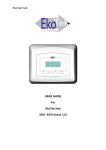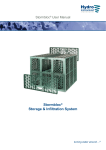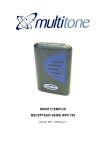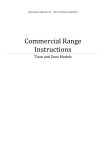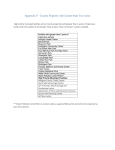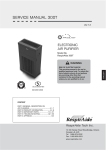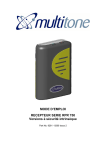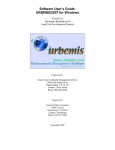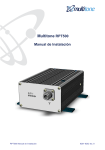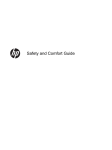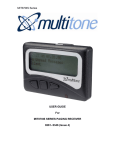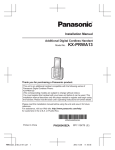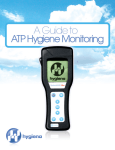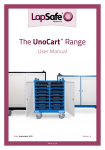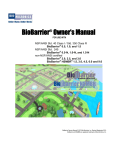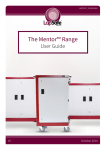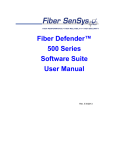Download Downstream Defender® - Hydro International
Transcript
Downstream Defender® User Manual Downstream Defender® Advanced Hydrodynamic Vortex Stormwater Treatment System turning water around ...® Advanced Vortex Technology; Optimal Removal and Retention The Stormwater Challenge The Water Framework Directive (WFD) is the single most important piece of water legislation to date. It is a mechanism to drive and achieve sustainable water resources in Europe, to manage and control impacts at source, and to collaborate for the long term. It is an over-riding principle of the WFD that diffuse pollution is managed at source to eliminate the discharge of hazardous substances. The Solution Hydro International’s Downstream Defender® is the most advanced hydrodynamic vortex separator available. The Downstream Defender® has verified removal efficiencies and is proven to prevent pollutant re-entrainment at high flows. 2 The Need to Control Urban Runoff Quality Urban runoff presents a number of challenges, in terms of both its quality and quantity. The natural environment has a capacity to absorb and control the transfer rate of stormwater. However, when this is replaced with impermeable surfaces (for example, roads and car parks), runoff rates can be increased significantly. The volume of runoff from surface flows also increases and the response time of the catchment changes. This can have a significant effect on the quantity and type of mobilised pollutants. Traditionally, the focus of attention has tended to be on quantity control to alleviate the flooding problems associated with increased runoff rates, with planning controls in place to limit the post-development runoff by providing storage or infiltration capacity on site. With the advent of the EU Water Framework Directive, it is becoming increasingly recognised that surface water runoff can be a significant source of pollution. National, regional and local regulations and guidelines are starting to come together to place increased emphasis on the control of Stormwater runoff quality. An up to date guide on current legislation and guidance in the UK can be found on our website at: http://www.hydro-international.biz/stormwater/legislation_and_guidlines.php 3 The Need to Control Urban Runoff Quality The Importance of Sediment Control Sediments play an important role in pollutant transport and dispersion. Sediment particles can adsorb charged chemical pollutants including phosphates and pesticides and are associated with other pollutants such as heavy metals and polycyclic aromatic hydrocarbons (PAHs). Sediment particles themselves are also a pollutant, tending to cloud water thereby blocking out light and smothering stream beds. Sediment accumulation within sewer / drainage networks can also present difficulties with blockages occurring which can contribute to surcharge of the system and surface flooding. The Environmental Impact of Pollutant Re-entrainment Pollutant re-entrainment is defined as the tendency for pollutants captured during a storm event to be re-suspended (or re-entrained) and discharged by flows resulting from a subsequent storm event. Rainfall patterns in the UK are notoriously unreliable and it is a generally accepted consequence of climate change, that extreme storm events could become increasingly common. This is very important in practice as the environmental benefits of the removal of pollutants at low flows is worthless if these pollutants are subject to re-entrainment during high flow storm events. Installation of a Downstream Defender® to protect an attenuation pond from grits, silts and oils from the local road and domestic surface runoff. The discharge from the pond is controlled by a Hydro-Brake® Flow Control. The completed, attenuation pond. The Downstream Defender® manhole can be seen in the foreground. 4 The Downstream Defender® The Downstream Defender® is the most advanced hydrodynamic vortex separator available for the removal of sediment, floatables and oil from stormwater runoff and operates on simple fluid mechanics. The Downstream Defender® is self-activating, has no moving parts, no external power requirement and is fabricated with durable non-corrosive components. No manual procedures are required to operate the unit and maintenance is limited to monitoring accumulations of stored pollutants and periodic clean-outs. The Downstream Defender® has been designed to allow for easy and safe access for inspection/monitoring and clean-out procedures. Entry into the unit or removal of the internal components is not necessary for maintenance, thus safety concerns related to confined-space-entry are avoided. The Downstream Defender® is proven to be more efficient than other structural treatment devices in as little as half of the footprint and is the only separator with internal components proven to prevent pollutant re-entrainment (washout). Downstream Defender® Components 1. Access for Removal of Floatables and Sediments 2. Inlet Pipe 3. Inlet Chute 4. Centre Shaft 5. Dip Plate 6. Centre Cone 7. Benching Skirt 8. Floatables and Oils Storage 9. Isolated Sediment Storage Zone 10. Outlet Pipe 1 4 8 8 2 10 3 5 7 5 6 9 5 Applications and Advantages Applications Advantages • Removal of sediment, floatables and petroleum • Most efficient separator available. products from surface water / stormwater flows. • Efficient over a wide range of flows. • Highway runoff. • Proven to prevent pollutant re-entrainment. • SUDS schemes. • Proven track record worldwide. • Soakaways and swales. • Small footprint. • Low Impact Development (LID) schemes. • Can be installed within the footprint of a carriageway • Wetland schemes. / embankment, avoiding the need for additional land • Basin and pond protection. take. • Park & Ride schemes. • Watercourse and pond protection. • Industrial and commercial areas. • Vehicle maintenance washdown yards. • Quarry settlement ponds. • Can be used as an alternative to a sedimentary forebay in a pond system. • Treatment of Park & Ride or commercial parking schemes with no loss of parking spaces. • Can be retrofitted to industrial and commercial sites without requiring extensive construction works. New Features • Low system headloss. • No moving parts and no power requirement. • Consolidates maintenance to a single centralised • High flow internal bypass configuration. • Able to incorporate a change of pipe direction location, helping to save time and costs on site between 90° and 270° - allowing changes of when compared to dispersed silt chambers or gully direction without additional manholes. pots. • Simplified installation procedure - all internal • Independently tested and verified performance. components are fitted into the chamber before • Approved by regulatory agencies throughout the world. delivery. Installation is now similar to that of a standard sectional manhole chamber. No confined space entry is required. Image shows a Downstream Defender® protecting a pond. 6 Case Study Applications Shortwood Pond A precious part of London’s remaining medieval common land has been saved from the threat of pollution from nearby highways with a simple solution, a 1.8 m Downstream Defender®. Runoff from nearby highways was threatening the precarious wetland habitat of Shortwood Pond - home to endangered species such as the Brown Galingale plant and the Little Whirlpool Ramshorn snail. This habitat is part of Staines Moor, located at the eastern end of Colne Valley Park, which contains many Sites of Special Scientific Interest. The Downstream Defender® is ideally suited to protecting the pond, because it separates out and retains the sediments. The entrapped solids and sediments are not washed out by high storm flows as they would be in conventional gully pots. The hydrocarbons and floatable portions are also retained. Hop Oast Park & Ride Facility The Hop Oast Park & Ride facility, designed in line with Horsham District Council’s policy of providing sustainable infrastructure and services, is used to reduce long stay parking in the town centre. Adding further to its green credentials, Horsham District Council installed a porous pavement with a Hydro Stormwater Management System to ensure controlled, unpolluted surface water discharge to the local watercourse. The surface water feeds into a Hydro Stormcell® modular stormwater storage system which retains the excess water and allows it to discharge under control via a 1.2 m Downstream Defender® and a 111 mm Hydro-Brake® Flow Control device, into a local watercourse. Any silt within the system is carried through to the Downstream Defender® where, due to its unique vortex action, sediment settles out in the easy access sump and hydrocarbon pollutants are separated into a collection zone; both can be easily removed periodically. 7 How it Works The Downstream Defender® internal components are designed to enhance the separation process by minimising headloss, increasing efficiency and preventing re-entrainment of captured pollutants. Advanced hydrodynamic separation is achieved by extending and stabilising the flow path, whilst isolating the captured pollutants in dedicated storage zones. Contaminated stormwater entering the unit is directed downwards and around the periphery of the chamber (green arrows). As flows increase, oils, litter and floatable material are initially captured at the inlet and transferred to the oil storage zone around the outer annulus of the chamber (brown area). The oil storage zone is protected from the treatment flow path and so prevents captured floatable materials being reentrained during peak flows. As the flow continues to spiral around the periphery of the chamber, low energy vortex motion directs settleable solids into the base of the unit (yellow arrows). The internal components isolate the base of the chamber from the treatment flow path preventing re-entrainment of captured solids. The treated stormwater exits the chamber via the orientated outlet pipe after ensuring the longest possible retention time within the unit (light blue arrows). Excess flows associated with extreme storm events bypass both the vortex treatment chamber and also both the sediment and oil storage zones. These excess flows pass forward untreated via the orientated outlet pipe. Flow Through the Downstream Defender® Access to the base of the chamber for sediment removal can be achieved via the centre shaft (dark blue arrow) using standard vacuum tanker equipment. The Downstream Defender® cover slab is fitted with access hole(s) to enable removal of captured sediment and floatable materials. Verification Verified Treatment Performance Hydro International has dedicated research and development facilities at both its UK and US offices, which allow for extensive full and model scale testing of units. These tests along with comprehensive Computational Fluid Dynamics (CFD) assessments and field monitoring programmes build up an accurate picture of pollutant removal and retention at high and low flows. These findings have been independently verified through 3rd party testing and certification programmes. A comprehensive review of assessments and approvals can be obtained from Hydro International on request. Hydro International has taken great care to ensure that the pollutants captured by the Downstream Defender® remain within the unit even under extreme storm conditions. CFD analysis combined with independent model scale testing has shown that the Downstream Defender® retains in excess of 99% of captured pollutants. 8 Verification Cont ... Model Scale Assessment by Liverpool John Moores University Model scale testing was carried out by Liverpool John Moores University’s Centre for Environmental Technology (LCET) to compare a number of different configurations of Stormwater treatment devices. A particular focus of the study was on the ability of the chambers to retain captured pollutants. For each chamber configuration, sediment was allowed to settle on the base of the chamber. The chamber was then subjected to moderate and high flow rates. Each test was filmed during the evaluation and the amount of sediment washed out of the chamber was measured at the outlet. This work concluded that chambers with an exposed sump (such as silt traps or simple gravity sedimentation devices) are prone to pollutant re-entrainment during high flow conditions. These devices retained less than 1% of sediment. The unique internal configuration of the Downstream Defender® meant that 99.7% of sediment was retained within the chamber even under high flow conditions. The images below show the start, middle and end frames from the video footage, comparing a Downstream Defender® to a simple linear gravity sedimentation chamber. Downstream Defender® Chamber Simple Linear Chamber Illustration of the importance of a protected sediment storage sump; the Downstream Defender® (top) is found to retain sediments, while those stored in a simple linear chamber (bottom) are quickly flushed out. 9 Verification Cont ... Analysis of Sediments Captured by Installed Units A number of field monitoring trials on installed units have been carried out, including a study by the University of Bristol that compared the physical and chemical characteristics of sediments captured at a number of units throughout the UK and Ireland. The evaluated systems included: • A motorway service station • A park and ride car park • A site during construction of a residential development • A residential development • An urban road The sites were monitored over a 10 month period and Sampling at South County, Dublin. demonstrated effective capture of pollutants, with some units recording as much as 3 m3 of sediment over the monitoring period. The sediment captured was found to be closely aligned in size and chemical content to what would commonly be found in treatment ponds. Samples collected from the six Downstream Defender® units. Computational Fluid Dynamics CFD techniques can be used to allow the assessment of real engineering systems on a computer simulation basis and are widely applied in the aerospace, automobile, oil and other high technology industries. Hydro International has pioneered the use of CFD in the water-environment sector and developed considerable experience in this area. Over 20 configurations of Stormwater treatment system have been analysed using CFD and have consistently been found to have lower pollutant removal efficiencies than the Downstream Defender® arrangement. CFD also demonstrates that the sump of the Downstream Defender® is shielded from the main treatment area with low flow velocities experienced in the sediment storage CFD plot of velocity magnitudes in the Downstream Defender®. zone. This explains the superior pollutant retention capacity of the Downstream Defender® when compared to other Stormwater treatment devices. Full details of testing and verification can be found in the ‘Downstream Defender® Overview of the Technology and its Verification’ document available from Hydro International 10 Detail Design System Performance Removal efficiencies listed below are achieved for all flows up to and including the Treatment Flow Rate as shown in Table 1 below. • Greater than 80% of grits and silts down to a particle size of 150 microns with a minimum specific gravity of 2.65 • Greater than 80% of light oil with a maximum viscosity of 5.5 (to EN858-1). Diameter of Unit Treatment Flow Rate (m) (l/s) Hydraulic Capacity (l) Oil Storage Capacity Sediment Storage (l) Capacity (m3) 1.2 21 120 270 0.7 1.8 51 300 1350 1.7 2.55 115 600 2500 3.8 3.0 160 750 4650 4.4 Table 1 Design Flows and Storage Volumes Notes:i) Flow rates in excess of the Treatment Flow Rate are possible, but removal efficiencies may be reduced – contact Hydro International for further information. ii) Head loss at Treatment Flow is typically less than 150 mm. iii) The Hydraulic Capacity is the maximum flow that can pass through the chamber without surcharge to the upstream network. 1) Sizing for Storm Peak Flow - Preferred Method The optimum design method is to select the unit size, such that the Treatment Flow (see Table 1 above) is close to the peak flow of the maximum storm event likely to be conveyed by the system. This design methodology maximises the treatment offered by the unit as all storms up to and including the peak flow of the maximum storm event achieve removal efficiencies in excess of 80% for oils and grits. Where the sewer system / drainage network includes latent capacity to provide a safety factor, excess / extreme flows are still conveyed without restriction through the Downstream Defender® unit with a significant proportion of the flow being treated. For example, if the Stormwater pipe network has been designed to convey the 1 in 5 year storm without any surcharge to the upstream network, then the Downstream Defender® should be sized for the peak flow likely to be experienced during a 1 in 5 year storm of any duration. 2) Sizing for Water Quality Volume - An Alternative Method The internal bypass configuration within the Downstream Defender® units, coupled with the unrivalled prevention of pollutant re-entrainment, means that the Downstream Defender® can be designed for the Water Quality Volume without the need for complex and potentially expensive diversion structures. Water Quality Volume is defined as treatment of 90% of the average annual runoff. Under Water Quality Volume design, the Downstream Defender® is sized such that the unit treatment flow is matched to the peak flow associated with the Water Quality Volume storm event. This storm event caters for 90% of annual rainfall events and is often referred to as the ‘First Flush’ and contains the majority of the pollutant load in the early stages of a given storm event. It is generally considered that the first flush is equivalent to a rainfall depth of 10-20 mm. As the sizing for Water Quality Volume design is based on annual return period storm events, the tendency will be for the system to experience flows in excess of the treatment flow and operate under bypass conditions more frequently than for Peak Storm Flow designs. 11 Detail Design 3) Sizing for Specific Pollutant Capture - Site Specific Method Under certain circumstances it may be desirable to size the Downstream Defender® to target pollutant particles of a defined size and specific gravity. For example, industrial sites where dust of a particular size and density is produced as a by-product of the manufacturing process and escapes into the drainage system. The flow rates directed through the Downstream Defender® can be determined such that removal of the target pollutant is optimised. For further information on sizing using Methods 1), 2) or 3), please contact Hydro International. Dimensions and Weights Unit External Diameter of Unit (m) Inlet & Outlet Pipe Diameter (mm) iii) Depth (m) A B 1.43 300 1.825 2.615 Component Depth i) Average Weight (kg) 0.135 412 2.615 3574 2.750 3986 0.160 1210 1.2 m Single Piece Unit with HD Cover Slab HD Cover Slab ii) Concrete Unit Including Base Total 1.8 m Two Piece Unit with HD Cover Slab HD Cover Slab ii) 3.003 7024 Concrete Unit - Base Section 1.375 4720 Total 4.035 12954 0.200 2766 3.000 9160 Concrete Unit - Top Section 2.16 450 2.500 3.875 2.55 m Two Piece Unit with HD Cover Slab HD Cover Slab ii) Concrete Unit - Top Section 2.85 600 2.950 4.750 Concrete Unit - Base Section 1.750 7687 Total 4.95 19613 0.200 4590 3.000 13410 Concrete Unit - Base Section 2.000 12142 Total 5.200 30142 3.0 m Two Piece Unit with HD Cover Slab HD Cover Slab ii) Concrete Unit - Top Section 3.35 750 3.125 5.000 Notes: i) For sectional units, Base and Top section component depths are shown as the total height during transportation / before assembly on site. The total unit depth is the depth of the assembled unit. ii) Cover slabs are heavy duty, can take main road loadings and are supplied with a single or double 600 x 600 mm access holes. iii) Inlet and outlets are supplied with cast-in holes only. No stub pipes are provided. Table 2 Dimensions and Weights 12 Detail Design Dimensions and Weights Cont... Refer to Table 2, Page 12 for dimensions. Precast Concrete Cover Slab Inlet Pipe Outlet Pipe B A Inlet Pipe Outlet Pipe - Change of Direction from 90° to 270° 13 Detail Design Downstream Defender® Construction Precast Concrete Chambers The Downstream Defender® units are manufactured as a joint venture between Hydro International and CPM Group. Downstream Defender® units are supplied to site with High Density Polyethylene (HDPE) internal components fully fitted into reinforced precast concrete chambers. The concrete chambers are manufactured using a combined Portland cement and pulverised fuel ash (pfa), manufactured to meet Design Class 4 as defined in BRE Special Digest “Concrete in Aggressive Ground” Part 4 High Density Polyethylene (HDPE) internal components fully fitted into a reinforced precast concrete chamber. Design for Specific Precast Products. The 1.2 m diameter units are supplied as a single piece chamber, complete with base slab and a separate heavy duty cover slab. The 1.8, 2.55 and 3.0 m units are supplied to site as sectional, two-piece chambers complete with base slab and a separate heavy duty cover slab. Cover slab being craned into position. High Density Polyethylene (HDPE) Chambers In certain conditions, it may not be practical to install the complete concrete chamber unit. Hydro International are able to supply lightweight Downstream Defender® units where the HDPE internal components are fitted to a structurally reinforced HDPE chamber, which would comply with a standard of construction approved by the British Board of Agrément (BBA). Further details on these units can be obtained from Hydro International. HDPE internals fitted to a reinforced HDPE chamber. 14 Installation Guidelines 1) General Guidelines 1.1)Handling The Downstream Defender® internal components are manufactured utilising highly durable high density polyethylene (HDPE) and are pre-installed into a bespoke CPM concrete chamber. Improper handling can result in damage to the components and/or the precast concrete chamber. Failure to comply with the Hydro International / CPM Group handling and installation guidelines voids all warranties. Upon delivery of Downstream Defender® components, inspect immediately for any damage sustained during transport. If any discrepancies or problems are found notify the supplier prior to unloading to initiate corrective action. Unloading of a damaged unit without notifying the supplier voids all warranties and releases liability of costs of repair or replacement from Hydro International or CPM Group. At all times during unloading and installation avoid any impacts to the units. Do not allow any of the components to be dropped, rolled or pushed. At no time shall anyone step, stand or otherwise place unnecessary load on the components. All components shall be lifted and moved using the designated lifting points giving firm and complete support to the unit. The Downstream Defender® shall be installed as soon as possible following delivery. Pending installation any loose components including universal head-links, sealant or seals shall be temporarily stored in an area protected from dirt and impact. 1.2) Site Preparation The chamber excavation shall be properly prepared in advance so that the unit may be installed as soon as practical upon delivery. The chamber excavation shall meet all minimum Health and Safety standards for construction. The area of excavation should be carefully checked for any other services. The chamber should be positioned such that it is at least 800 mm away from any other services. A sub-base of compacted stone or concrete (depending on site conditions and considering the weight of the unit and the contained water during usage) must be level and at the correct elevation prior to placing the Downstream Defender® concrete chamber into the excavation. 15 Installation Guidelines 2) 1.2 m Diameter Unit 2.1) Component Weights Cover Slab = 412 kgs Concrete chamber with internals = 3574 kgs 2.2) Lifting and Moving The 1.2 m unit is lifted as a single complete unit using a pair of universal head-links (supplied with unit) which hook under the head of the cast-in lifting anchor. These are located opposite each other on the outside surface of the unit and engage as shown right: Chain sling to be supplied by the customer, minimum leg length 3 m. Cover slab requires a three legged chain sling (supplied by the customer). 2.3) Installation Off-load the ready to install precast concrete chamber containing the Downstream Defender® components and position it in the prepared excavation. Ensure the inlet and outlet are correctly orientated and the unit has been checked for line and level. Make sure all the internal equipment is in place and no tools or loose items have been left in the unit. Place the Butyl sealant around the top surface of chamber then install the cover slab. The cover slab should be orientated such that the access hole is above the inlet pipe as shown in the diagram opposite. The unit can now be carefully back filled with suitable material to a level below the inlet and outlet pipes ready for final pipe connection. The inlet/outlet pipes can now be connected. Setting-to-work - fill the chamber with clean water until the discharge from the outlet commences. Single Piece Installation & Cover Slab Orientation 16 Installation Guidelines 3) 1.8 Diameter Unit 3.1) Component Weights Cover Slab = 1210 kgs Concrete base with internals = 4720 kgs Concrete body with internals = 7024 kgs 3.2) Lifting and Moving The 1.8 m unit is lifted as two separate chamber sections using a pair of universal head-links (supplied with the unit) which hook under the head of the cast-in lifting anchor. These are located opposite each other on the outside surface of the base and body sections and engage as shown opposite Chain sling to be supplied by the customer, minimum leg length 3 m. Cover slab requires a three legged chain sling (supplied by the customer). 3.3) Installation Lower the base section containing the benching skirt into position in the excavation ensuring to check line and level. Position the seal provided and carefully lower and guide the main body section onto the base section. Ensure the inlet and outlet holes are correctly orientated. Check for line and level. NOTE: The centre shaft should still be in its raised transport position to ensure the shaft and cone are Body protected while the sections are being lifted and moved into position. The unit can now be carefully back filled with suitable material to a level below the inlet and outlet pipes ready for final pipe connection. The inlet/outlet pipes can now be connected. Carefully back fill the remaining excavation so that only the top 150 mm (approximately) of the chamber is visible. Base Two-piece Installation 17 Installation Guidelines 3.3) Installation Cont... Once placed and back filled, the centre shaft and cone can then be released and lowered into place. To release and lower the centre shaft SAFE ACCESS to the centre section of the Downstream Defender® must be used. Attach the centre shaft to the lifting equipment via the 2 lifting hole points. Remove the fixing straps. Lift the centre shaft a small amount to allow it to be rotated Centre Shaft and Cone Detail so that the 4 supporting ribs can drop down through the corresponding slots in the top of the unit. The centre shaft should then be slowly lowered so that the flange sits down flat onto the top of the unit. Fix the centre shaft in place using 6 off M10 x 50mm stainless steel bolts and washers (supplied). Fixings for Centre Shaft Place the Butyl sealant around the top surface of chamber then install the cover slab. The orientation of the access is with the offset hole above the inlet pipe as shown right. Setting-to-work. Fill the chamber with clean water until the discharge from the outlet commences. Cover Slab Orientation 18 Installation Guidelines 4) 2.55 m Diameter Unit 4.1) Component Weights Cover Slab = 2766 kgs Concrete base with internals = 7687 kgs Concrete body with internals = 9160 kgs 4.2) Lifting and Moving The 2.55 m unit is lifted as two separate pieces using 4 No. M30 lifting loops (supplied with the unit). These are located opposite each other on the upper surface of the base and body sections and screw into inserts cast into the concrete sections 4 legged Chain sling to be supplied by the customer, minimum leg length 3.5 m. Cover slab requires a three legged chain sling (supplied by the customer). 4.3) Installation Lower the base section containing the benching skirt into position in the excavation ensuring to check line and level. Position the seal provided and carefully lower and guide the main body section onto the base section. Ensure the inlet and outlet holes are correctly orientated. Check for line and level. Body NOTE: The centre shaft should still be in its raised transport position to ensure the shaft and cone are protected while the sections are being lifted and moved into position. The unit can now be carefully back filled with suitable material to a level below the inlet and outlet pipes ready for final pipe connection. The inlet/outlet pipes can now be connected. Base Carefully back fill the remaining excavation so that only the top 150 mm (approximately) of the chamber are visible. Two-piece Installation 19 Installation Guidelines 4.3) Installation Cont... Once placed and back filled, the centre shaft and cone can then be released and lowered into place. To release and lower the centre shaft SAFE ACCESS to the centre section of the Downstream Defender® must be used. Attach the centre shaft to the lifting equipment via the 2 lifting hole points. Remove the fixing straps. Lift the centre shaft a small amount to allow it to be rotated Centre Shaft and Cone Detail so that the 4 supporting ribs can drop down through the corresponding slots in the top of the unit. The centre shaft should then be slowly lowered so that the flange sits down flat onto the top of the unit. Fix the centre shaft in place using 6 off M10 x 50 mm stainless steel bolts and washers (supplied). Fixings for Centre Shaft Place the Butyl sealant around the top surface of chamber then install the cover slab. The orientation of the access is with the offset hole above the inlet pipe as shown opposite. Setting-to-work. Fill the chamber with clean water until the discharge from the outlet commences. Cover Slab Orientation 20 Installation Guidelines 5) 3.0 m Diameter Unit 5.1) Component Weights Cover Slab = 4590 kgs Concrete base with internals = 12142 kgs Concrete body with internals = 13410 kgs 5.2) Lifting and Moving The 3.0 m unit is lifted as two separate pieces using 4 No. M30 lifting loops (supplied with the unit). These are located opposite each other on the upper surface of the base and body sections and screw into inserts cast into the concrete sections 4 legged Chain sling to be supplied by the customer, minimum leg length 4.0 m. Cover slab requires a three legged chain sling (supplied by the customer). 5.3) Installation Lower the base section containing the benching skirt into position in the excavation ensuring to check line and level. Position the seal provided and carefully lower and guide the main body section onto the base section. Ensure the inlet and outlet holes are correctly orientated. Body Check for line and level. NOTE: The centre shaft should still be in its raised transport position to ensure the shaft and cone are protected while the sections are being lifted and moved into position. The unit can now be carefully back filled with suitable material to a level below the inlet and outlet pipes ready for final pipe connection. The inlet/outlet pipes can now be connected. Base Carefully back fill the remaining excavation so that only the top 150 mm (approximately) of the chamber are visible. Two-piece Installation 21 Installation Guidelines 5.3) Installation Cont... Once placed and back filled, the centre shaft and cone can then be released and lowered into place. To release and lower the centre shaft SAFE ACCESS to the centre section of the Downstream Defender® must be used. Attach the centre shaft to the lifting equipment via the 2 lifting hole points. Remove the fixing straps. Lift the centre shaft a small amount to allow it to be rotated so that the 4 supporting ribs can drop down through the Centre Shaft and Cone Detail corresponding slots in the top of the unit. The centre shaft should then be slowly lowered so that the flange sits down flat onto the top of the unit. Fix the centre shaft in place using 6 off M10 x 50 mm stainless steel bolts and washers (supplied). Fixings for Centre Shaft Place the Butyl sealant around the top surface of chamber then install the cover slab. The orientation of the access is with the offset hole above the inlet pipe as shown opposite. Setting-to-work. Fill the chamber with clean water until the discharge from the outlet commences. Cover Slab Orientation 22 Inspection and Maintenance Notes: 1. Contaminated stormwater can contain substances harmful to human health. Any person carrying out maintenance on the equipment should wear suitable protective clothing, including gloves. Good hygiene practice should also be observed. 2. When covers are removed precautions must be taken against the risk of falling in to the unit. 3. Where the Downstream Defender® and / or upstream / downstream structures are situated within trafficked areas, appropriate traffic management measures must be in place prior to inspection / maintenance work. The internal components of the Downstream Defender® are designed not only to enhance the removal process, but also to isolate the captured pollutants from the treatment flow path. This has been proven to prevent washout / re-entrainment of pollutants during high intensity storms. The Downstream Defender® unit has been designed so that all normal inspection and maintenance can be carried out from the surface and no internal parts need to be moved or removed. Therefore no confined space entry is required. 600 x 600mm access holes are provided on the Downstream Defender® cover slab to enable Floatables Storage Zone access to the captured pollutants storage zones. A central access point provides access via the central shaft of the chamber to the sediment storage zone at the base of the chamber. On smaller units this central access point also allows access to the floatables storage zone. For larger units a secondary access point is provided over the inlet to allow access to the inlet and floatables storage zone. An effective, site-specific maintenance schedule should be developed to ensure that the stormwater is being collected and directed through the Downstream Defender® unit correctly and also to ensure that the volume of captured pollutants does not exceed the storage capacity within the unit. Whilst the maintenance required for each installation will vary depending on the local site conditions (ie. catchment area, pollutant loadings, storm frequency and intensity, etc.) the following Sediment Storage Zone general guidelines can be used during development of the site-specific maintenance schedule. The unit should be inspected at site hand-over / during the adoption phase to ensure that the unit has been correctly installed, that all internal components are free from damage, that no construction debris has entered the unit and that stormwater can freely flow through the unit. Inspections should initially be carried out at six monthly intervals and an annual clean-out should be conducted to monitor and remove pollutants and ensure proper operation and free flow of stormwater through the unit. The inspection and maintenance intervals can be adjusted once sufficient site specific data has been accumulated to give an accurate indication of the operation of the installed unit. 23 Inspection and Maintenance Typical Maintenance Schedule Activity Inspection Frequency Inspect for evidence of poor operation. At site hand-over then every six months. Inspect sediment and floatables accumulation rates and establish removal frequencies. Regularly during first year of operation, then every six months or as required. Regular Maintenance Sediment removal. Annual or as required. Floatables removal. Annual or as required. Remedial Action Sediment removal. Following spill in drained area. Floatables removal. Following spill in drained area. It is highly recommended that accurate inspection and maintenance logs are compiled and retained on record. The maintenance logs should include observations (and ideally photographs) of the unit as well as the volume of sediment, oils and floatables removed during each maintenance visit. Inspection Guidelines 1) Inspection visits should be coordinated with the property owner, facilities manager or assigned contact person to ensure that access to the Downstream Defender® chamber and the manholes immediately upstream and downstream of the unit is possible. 2) The upstream and downstream manholes should be inspected to ensure that debris is not preventing Stormwater from being collected in the drainage system and directed into the Downstream Defender® unit. Any debris should be removed and disposed of according to local guidance / regulations. 3) The Downstream Defender® unit should be inspected for accumulation of captured pollutants. The inlet of the Downstream Defender® should be inspected to ensure that there is no excessive build up of captured material. Free flow of water through the unit should be verified. 4) Inspection records should be completed and retained for each visit. Depth Gauge Measurement of Captured Sediment 24 Inspection and Maintenance Maintenance Guidelines Note: Whilst the Downstream Defender® internal components are manufactured utilising highly durable HDPE, care should be taken during maintenance operations. Improper handling can result in damage to the components. 1) For most installations, sediment and associated pollutants are considered Hazardous Waste (England and Wales) or Special Waste (Scotland). This classification imposes a Duty of Care on the waste producer to notify the Regulator and to ensure that the waste is stored, transported and disposed of in an appropriate manner. All movements of Special or Hazardous Waste must be accompanied by the appropriate consignment note(s). Chemical analysis of captured pollutants may be beneficial especially for higher risk sites where the potential for spills or accumulation of Special or Hazardous Waste exists. 2) Removal of floatables and sediment from the Downstream Defender® unit should be carried out using a vacuum tanker or similar and carried out by a suitably licensed body. 3) Evacuation of the captured pollutants should be performed by fully trained and authorised personnel only and the equipment used, such as cleaning hoses, must be equipped with protective nozzles to avoid damage to the Downstream Defender® components. 4) Following emptying of the unit, the internal components Cleaning of Internal Components and Pollutant Removal via Vacuum Tanker Hose. should be cleansed using clean water and checked for signs of damage. It is recommended that a photographic record of the unit is taken at each visit and retained on record. Any damage liable to affect the operation of the unit should be reported immediately to the supplier accompanied by photographic evidence identifying the fault. 5) After cleansing the unit should be filled with clean water (not black water) until discharge from the outlet commences. Free discharge from the unit should be verified. 6) All covers should be securely replaced. 7) Maintenance records should be completed and retained following each visit. 25 Integrated Stormwater Systems As with all Hydro’s Stormwater Systems, Downstream Defender® Separators can be integrated with or used in place of what are becoming increasingly known as ‘soft’ SUDS solutions (such as swales, ponds, lagoons etc). Hydro International is committed to providing integrated products and solutions that support Sustainable Drainage Systems. In addition to Downstream Defender®, Hydro International also provides other solutions for commercial developers and designers. Combined, our products provide comprehensive sustainable solutions to meet the most stringent regulations. Our Stormwater Product Portfolio includes: Stormbloc® Stormwater Storage and Infiltration System Hydro-Brake® Flow Control A block type structure with control that provides superior a patented maintenance hydraulic performance over / inspection tunnel for conventional flow regulators with providing underground patented features that reduce surface water infiltration and maintenance requirements. Our storage systems. STH range of Hydro-Brake®s is A self-activating vortex flow the only BBA Approved vortex flow control. ® Stormbloc Inspect A stackable modular access unit offering unrivalled Downstream Defender® accessibility to any An advanced hydrodynamic STH Range of Hydro-Brake® Flow Controls vortex separator designed to ® Stormbloc installation. remove sediment, floatables and associated pollutants from Stormcell® and Stormcell® Lite Stormwater Storage Systems stormwater. A low cost underground storage Up-Flo™ Filter system suitable for installation A high-rate modular stormwater beneath roads, car parks and treatment filter featuring a patented amenity areas. Stormcell® is upward flow path with a unique installed utilising a patented pipework system which Drain Down design. The filter prevents the entry of silts and targets a wide range of pollutants including floatable debris, fine grits into the storage volume. sediments, nutrients, metals, oils StormBank® Rainwater Harvester and grease, organics and bacteria. StormBank® can be used Hydro Filterra® Bioretention System to replace treated mains An enhanced biofiltration system water for use in toilets, that packages indigenous garden and outdoor use. vegetation with engineered soils StormBank® Pro for large for high levels of stormwater commercial developments treatment. The small footprint and StormBank® Garden makes it ideal for both new (exclusively for garden developments and retrofit to watering) are also available. existing ones. Visit: www.savetherain.info 26 For more than 30 years Hydro International’s commitment to product research and development has set industry standards. With a proven track record Downstream Defender® is the setting the standard technology driving design stormwater treatment separator you can trust. Our History Our Advantage Hydro International was formed in 1980 to promote Hydro International is committed to a policy of continuous the hydrodynamic separator and vortex flow control product development. Our understanding of integrated water management ensures that sustainable site-specific technology around the world. solutions set the standards. We have also been promoting source control and what are now commonly known as Sustainable Drainage To ensure that research outputs are of the highest Systems (SUDS) for well over a decade. quality, Hydro International utilises state-of-the-art testing technology and analytical techniques both in-house and through independent centres of excellence. Contact us Today If you require assistance with design or would like further information on any of our other stormwater products, call us at 01275 337977 or visit us on-line at www.hydro-international.biz. We look forward to working with you. 27 w w w.h y d r o- i nt er nat i onal . bi z Hydro International Stormwater Shearwater House • Clevedon Hall Estate Victoria Road • Clevedon • BS21 7RD Tel: 01275 878371 • Fax: 01275 874979 United Kingdom United States Ireland Hydro International Water & Wastewater Prickwillow Road Ely Cambridgeshire CB7 4TX Hydro International Stormwater & Wet Weather 94 Hutchins Drive Portland, ME 04102 Hydro International Wastewater 2925 Aloclek Drive Suite 140 Hillsboro, OR 97124 HRD Technologies Tootenhill House Rathcoole Co Dublin Tel: +44 (0) 1353 645700 Fax: +44 (0) 1353 645702 Tel: +1 (207) 756 6200 Fax: +1 (207) 756 6212 Tel: +1 (503) 615 8130 Fax: +1 (503) 615 2906 Tel: +353 (0) 1 4013964 Fax: +353 (0) 1 4013978 abcdef abcdef Certificate No. 4004540 Seacourt Logo Here © 2010 Hydro International. All rights reserved. DDUM A/1110 Certificate No. 0961366




























